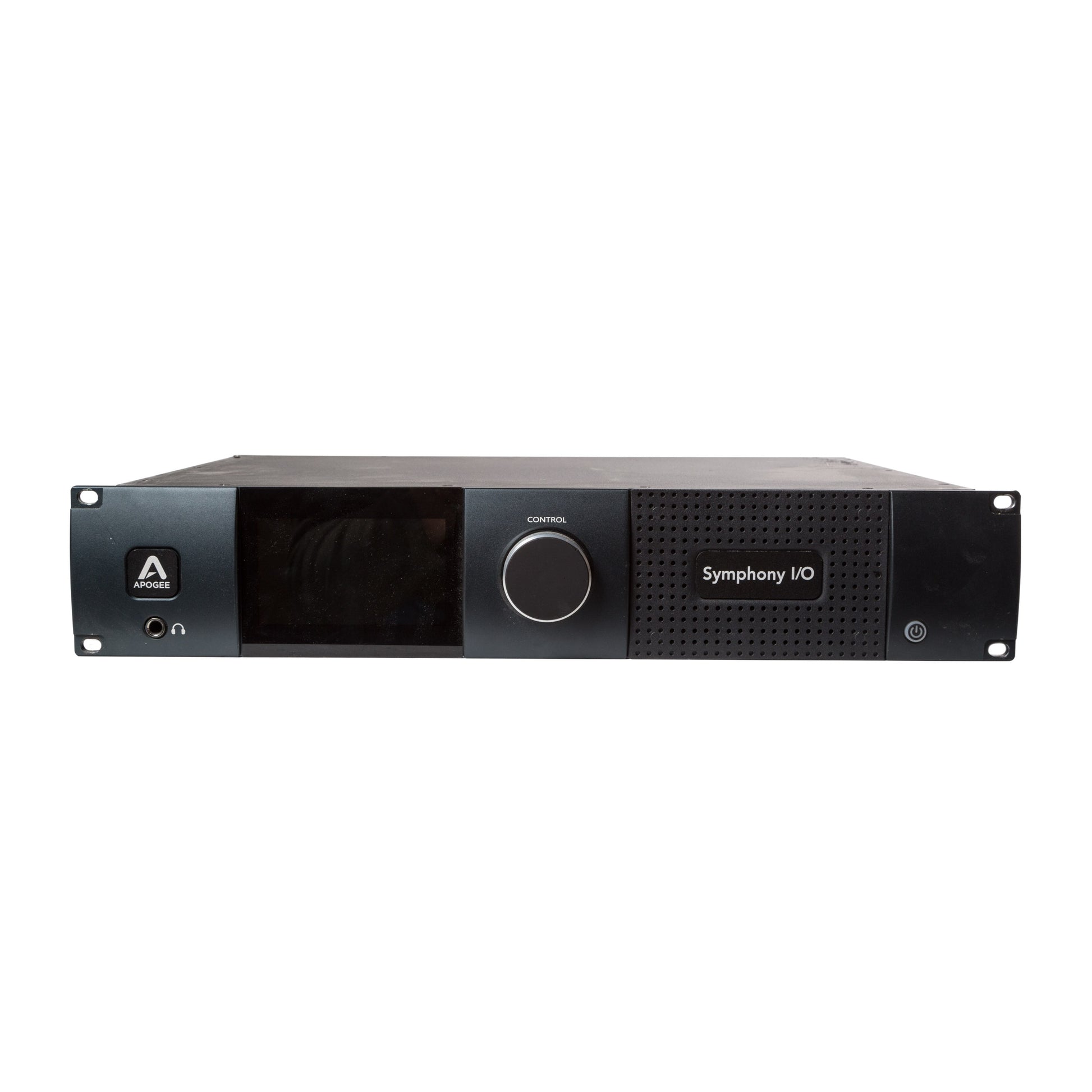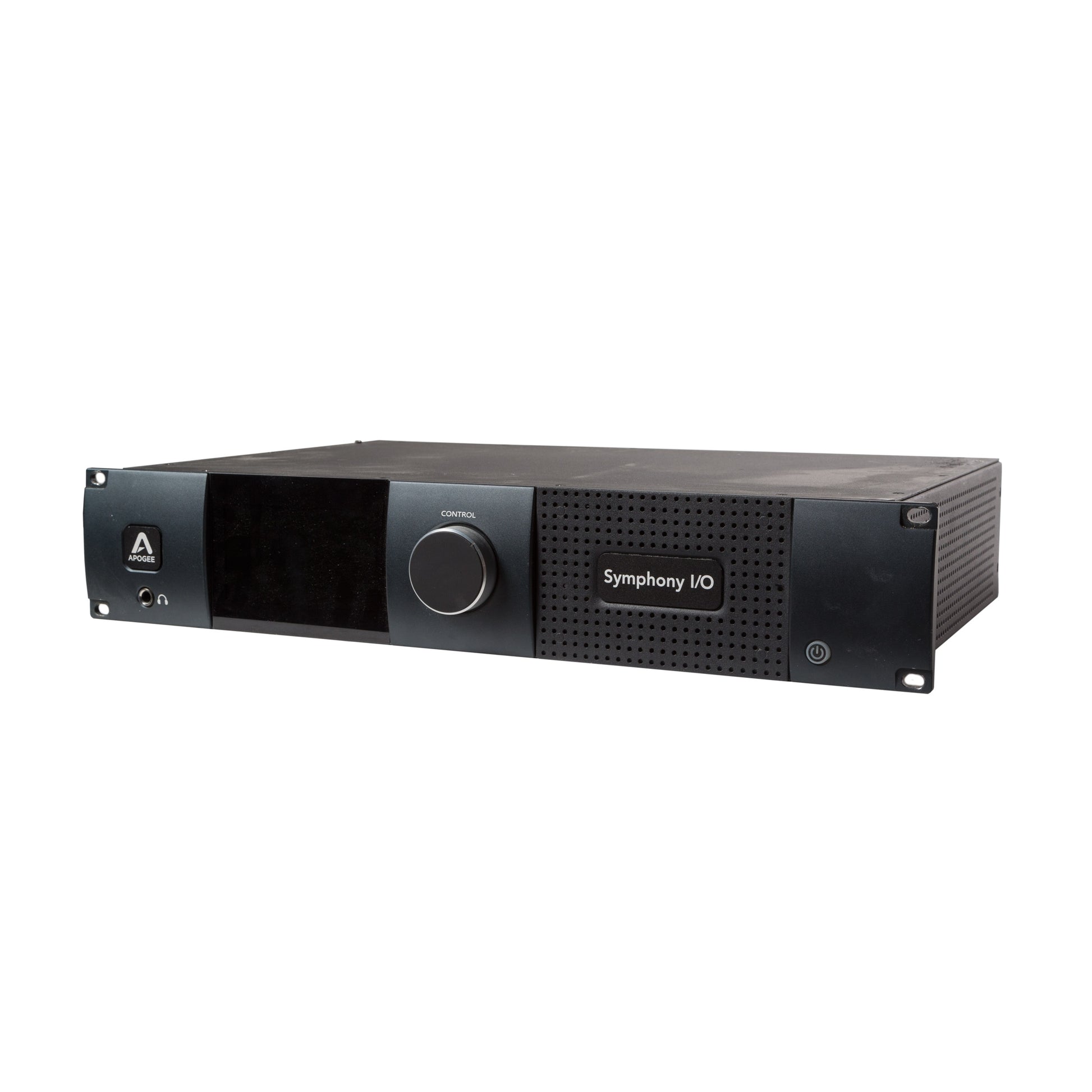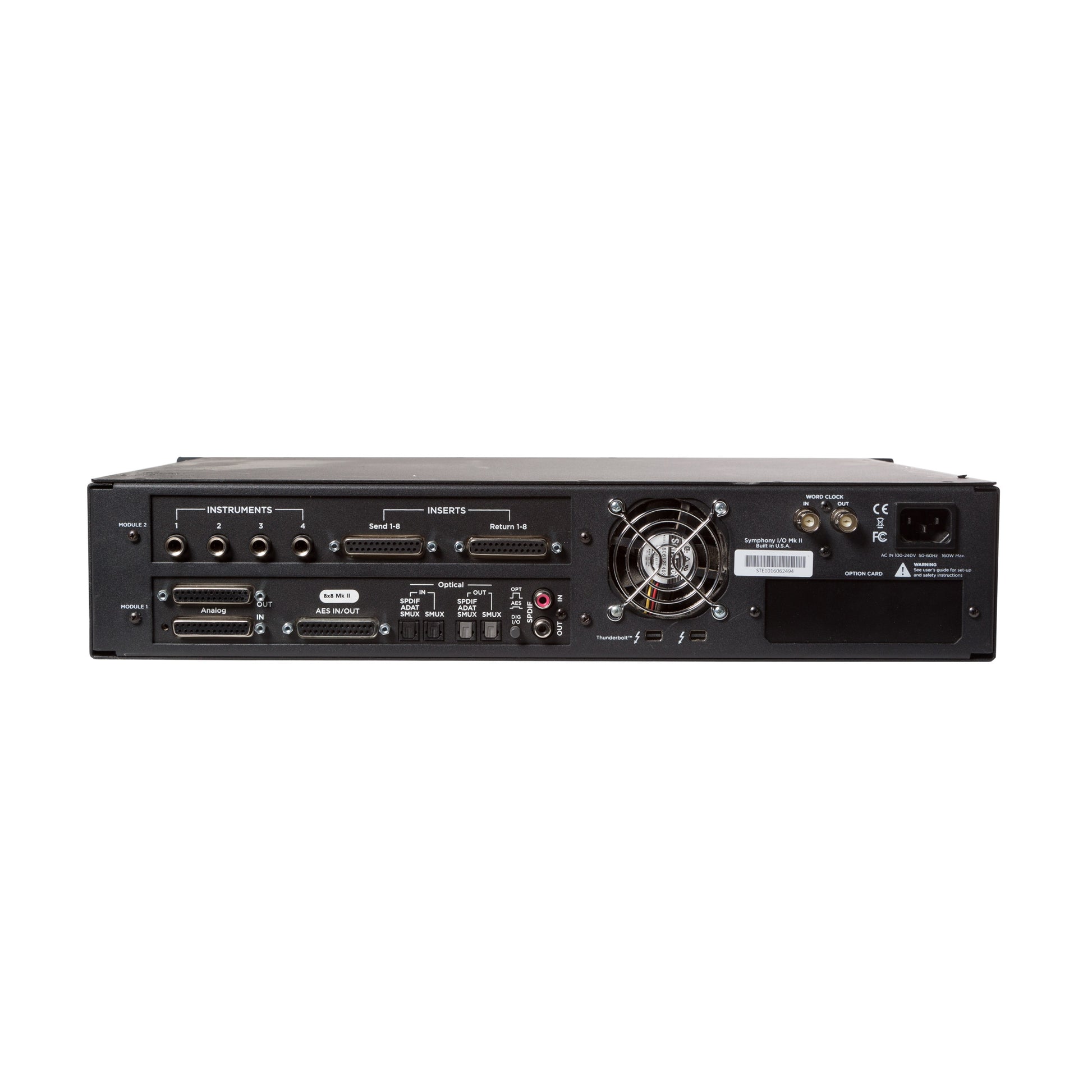

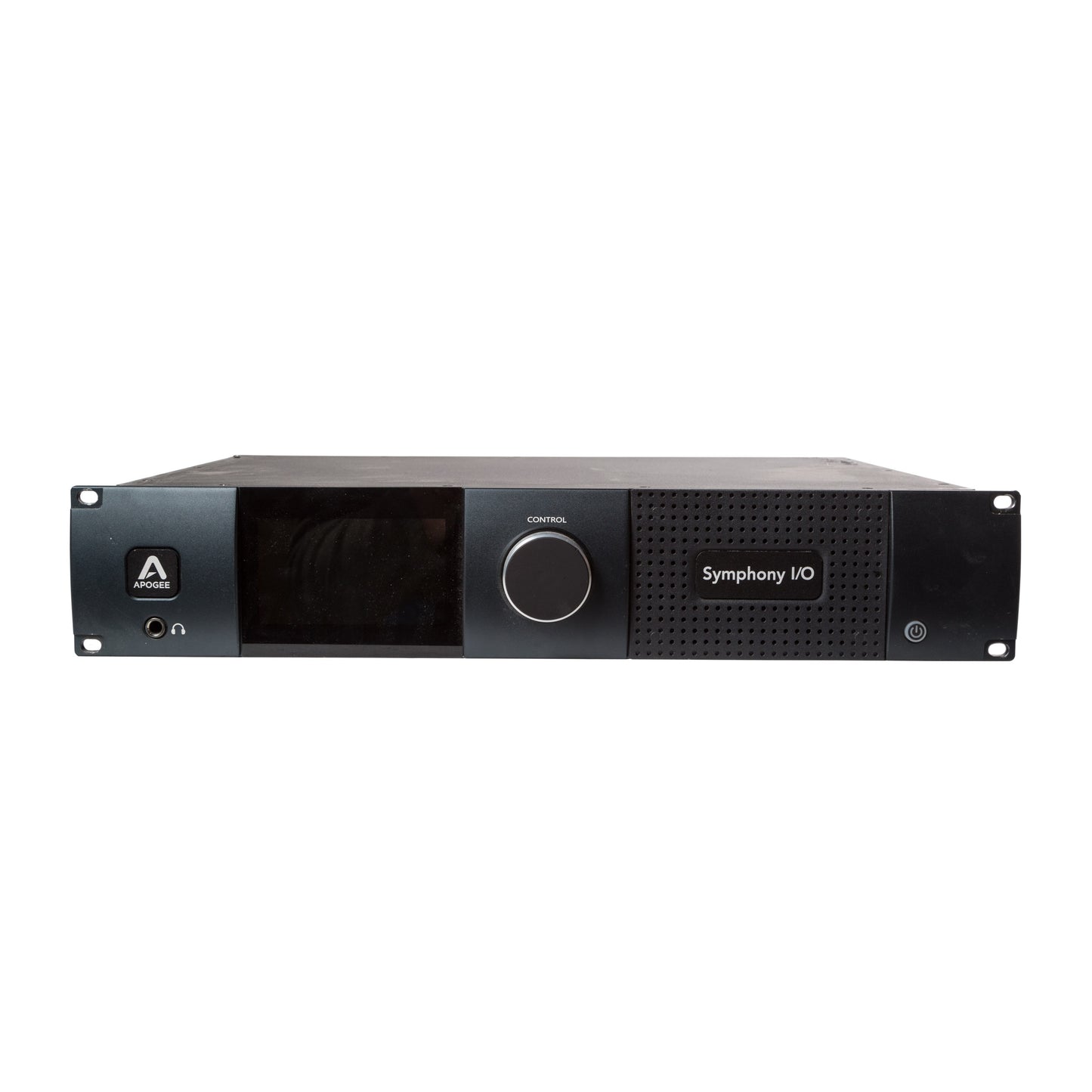
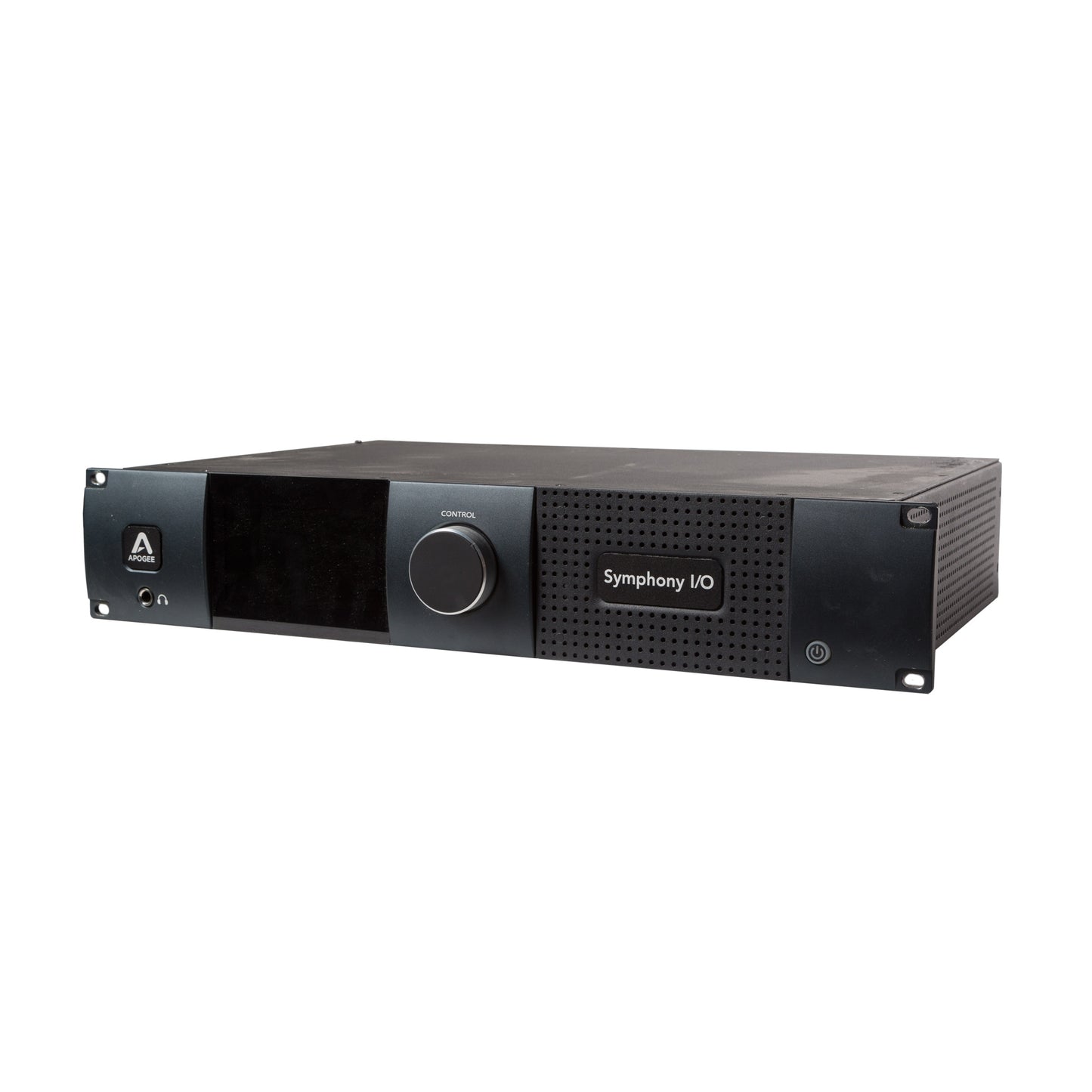
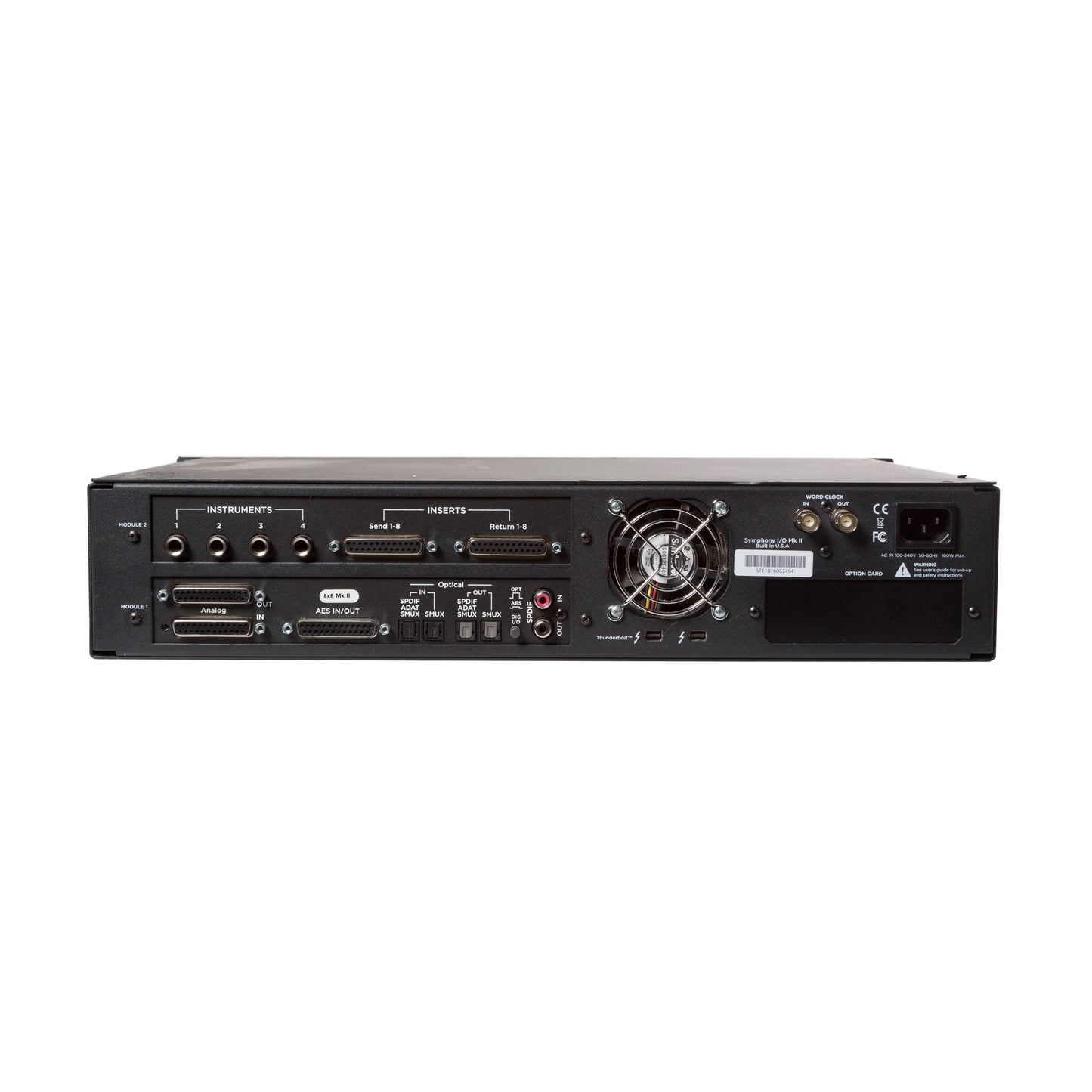
- Details
- Features
- Tech Specs
- Reviews
Symphony I/O Mk II is a multi-channel audio interface featuring Apogee’s newest flagship AD/DA conversion, modular I/O (up to 32 inputs and outputs), intuitive touchscreen display and optional world-class microphone preamps. Designed to deliver professional sound quality for audio recording, mixing and mastering, Symphony I/O Mk II is the ultimate music production centerpiece for any modern studio.
The new Symphony I/O Mk II comes with direct connectivity to one of three different platforms – Thunderbolt™, Pro Tools® HD or Waves SoundGrid® network.
Input And Output Flexibility
There is a Symphony I/O Mk II solution for everyone; the home studio, project studio, commercial recording studio and scoring stage. Choose from four base I/O configurations, 2×6, 8×8, 16×16, or 8×8 with 8 mic preamps and easily expand as your studio grows. With two module slots and the capacity for up to 32 inputs and outputs of A/D & D/A conversion per unit, Symphony I/O Mk II offers the best per-channel value of any interface in its category.
Legendary Sound Quality
Apogee engineers have made it their passion to improve every new flagship product by using the latest in electrical components and designing optimized circuitry that often exceeds the expectations of the component manufacturer. This is the Apogee Advantage. Symphony I/O Mk II is the culmination of this 30 year commitment and raises the bar on all Apogee products before it with even better audio clarity and sonic transparency. In fact, when equipped with either the new 8×8 or 16×16 Mk II I/O modules, Symphony I/O Mk II outperforms all other multi-channel audio interfaces available for Pro Tools HD or Thunderbolt based systems, making it the flagship audio interface for the entire professional audio industry and the obvious choice for countless GRAMMY winning artists, producers, songwriters and engineers.
The Magic Is In The Modules
The I/O Modules are the sound and soul of Symphony I/O Mk II, and represent over 30 years of Apogee R&D and design excellence. These powerful Modules deliver Apogee’s core competency: superior sounding digital audio recording. With 3 available I/O Modules and an 8 channel mic preamp module, you can choose from base configurations or expand to grow your studio’s capabilities.
Symphony’s I/O modules are designed to future-proof your investment in flagship Apogee sound quality. If you own an original Symphony I/O, the Symphony I/O Mk II chassis can increase the longevity of your system by offering backwards compatibility with first generation 2×6, 8×8, 16×16 and 8 channel mic preamp I/O modules.
Option Card Slot For Future Connectivity Options
Symphony I/O Mk II’s new option card feature will future proof your investment and your studio. Working in Pro Tools HD now? Thinking about going Native with Thunderbolt or setting up an audio over ethernet network? The Option card slot offers flexibility for the present and the future, as new platforms develop and audio recording workflows evolve.
Front Panel Touchscreen With Comprehensive Control
All of Symphony I/O Mk II’s essential input and output settings can be accessed from the front panel touchscreen. Change your input selection, monitoring levels, mic pre gain or calibrate your Symphony I/O Mk II to match the levels of the other analog gear in your system.
A high-resolution TFT display delivers all the visual feedback critical for recording and monitoring. Without looking at your computer, Symphony I/O Mk II lets you see metering for up to 64 channels of I/O, 32 IN x 32 OUT – signal levels, polarity, muting, and phantom power.
Dynamic Temperature Control
Symphony I/O Mk II features advanced controls to keep the unit running at an ideal temperature, ensuring the highest level of performance and reliability. The new temperature controls are complemented by an improved fan and chassis ventilation design, which allows adequate component cooling to occur quietly.
Symphony Control Software
Symphony Control software for Mac, is designed specifically for Symphony I/O Mk II audio interfaces. Symphony Control has been built from the ground up and replaces Apogee’s Maestro software for Symphony I/O Mk II users. Symphony Control delivers all the functionality of Maestro in a new, highly customizable user interface along with innovative new features like Talkback functionality, the simplified “Essentials” control window and an FX Send mixer feature, recently introduced as part of the Element Control software.
Apogee Control Hardware Remote Accessory
Symphony Control also provides compatibility between Symphony I/O Mk II audio interfaces and the Apogee Control hardware remote accessory. Apogee Control gives you instant access to input and output levels using the large Symphony-inspired Control knob and 3 control knob focus buttons, plus direct access to a wide range of software functions using the 8 user-configurable hardware buttons. Apogee Control hardware remote connects directly to your Mac using the included USB cable. Apogee Control is $195 USD and is sold as a separate accessory by authorized Apogee dealers worldwide. US customers can purchase Apogee Control in the Apogee web store.
With the introduction of Symphony Control, customers can now use 2 Symphony I/O Mk IIs simultaneously for up to 64 channels of I/O over a Thunderbolt connection to their Mac. Symphony I/O Mk II combined with Logic Pro on a Mac delivers the most advanced native workstation available with superior quality high-channel count recording at incredibly low latency.
Standalone Routing lets you setup and use Symphony I/O Mk II without a computer. From the front panel touch screen you can set up Symphony I/O Mk II for use in these situations and more.
Hi-Fi Systems
Connect Symphony I/O MkII to a Blu/Ray, CD Player or Power Amp for high end speakers. Symphony I/O Mk II is also an ideal high-end headphone amp.
Windows Workstations
May use a third party ADAT or AES PCI interfacing card to use Symphony I/O MkII converters on a Windows Machine.
Standalone Converter
Standalone AD/DA converters can be used alongside other digital gear: To expand other interfaces, to connect to live or studio digital consoles, to connect to broadcast equipment. With Standalone mode you can also bypass the converters of your existing gear.
Why Do I Need A Good AD/DA Converter?
Whether you record with a vintage Neve console, the best Neumann microphones or colorful mic preamps, a high quality AD converter is imperative to capture every nuance of your analog gear into your DAW. Without this, you will miss many of the subtleties and details that simply cannot be added back later with plugins. Similarly, the DA stage is essential to your perception of the recorded audio tracks. When mixing, regardless of what speakers you are using, if the converter is masking or having any effect on your audio, you could end up overcompensating with EQ, compression or other effects and failing to address other problematic details.
With Symphony I/O Mk II, you will hear more definition in each track and instrument of the mix, making it easier for you to make intelligent adjustments and achieve the ideal balance. Tracks will blend more harmoniously and mixing will simply be easier. The high end will be clear and not as brittle while the low end will be tighter than ever and more defined. This sort of unmatched audio quality can be noticed and appreciated by any listener.
Apogee Engineering Advantage
For over 30 years, Apogee has consistently redefined the state of the art in digital audio hardware design. We never rest on the laurels of our previous award-winning products – we’re constantly evaluating the latest technological developments in analog and digital components, platform connectivity and user interface advances to design better performing, intuitive products that meet the needs of any audio professional.
As an example of the Apogee Advantage, Symphony I/O Mk II uniquely employs a fully differential op-amp as a fundamental building block throughout its analog circuits. The very latest iterations of this technology offer astounding performance – vanishingly low noise and distortion, lightning-fast slew rate and out-sized current output capability, all in a power efficient and small package. These components offer performance that’s orders of magnitude superior to what’s found in most competitive audio interfaces, and are an important factor in Symphony I/O Mk II’s ability to offer up to 32 channels of state-of-the-art conversion in one 2U package at an incredible price per channel value.
Mk II Sound Quality – New 8×8 And 16×16 Modules
Like every flagship product we’ve introduced, Symphony I/O Mk II benefits from on-going expertise that constitutes the Apogee Engineering Advantage, once again pushing forward the state-of-the-art.
Symphony I/O Mk II includes the most refined analog-to-digital converter we’ve ever designed. The analog stage uses the same fully differential op-amps as found in the original Symphony I/O, but now in a circuit precisely streamlined to provide the most transparent path to the A/D stage possible.
Symphony I/O MK II’s D/A section has been optimized with a more powerful, robust analog output driver. This newly designed high current, low impedance circuit is capable of driving virtually any input with absolutely no decrease in performance, regardless of the load presented by the connected gear. This becomes especially important when connecting vintage gear with difficult load impedances and elevated operating levels, sometime over long cables – Symphony I/O MK II maintains fidelity and punch.
Audiophile-Grade Headphone Monitoring With Constant Current Drive
Symphony I/O Mk II features a single ultra high-fidelity DAC and headphone amplifier featuring Apogee’s Constant Current Drive technology, first introduced in the Apogee Groove. This unique approach to headphone amplification dynamically compensates for the nonlinearities of any connected headphones, providing massive power while maintaining extremely low distortion and linear frequency response.
Includes ESS Sabre32 DAC Technology
ESS Sabre32 32-bit Hyperstream DAC with Time Domain Jitter Eliminator offers unequalled dynamic range, ultra low distortion, and unmatched audio clarity free from input jitter.
A Difference You Will Hear
Apogee is an award-winning industry leader in digital recording technology with over 30 years of experience. Preferred by recording pros around the world, Apogee products like Duet, Quartet, Ensemble and Symphony I/O have been instrumental in creating countless GRAMMY® and OSCAR® winning recordings and have set the industry standard in professional recording for over two decades. Symphony I/O Mk II is built solidly on this reputation.
| Product Name | Apogee Symphony Analog I/O MK2 Thunderbolt Chassis - 8x8 + 8MP |
|---|---|
| Brand | Apogee |
| Condition | New |
| MPN | SYM2-8X8XS2-A8MP |
| UPC | 805676301570 |
| Shipping Option | Free Shipping to the Continental U.S. |
- Best AD/DA conversion of any Thunderbolt™ audio interface
- Up to 32 channels of modular analog I/O with optional 8 mic preamps
- Best per-channel value of any interface in its category
- Choice of Thunderbolt, Pro Tools® HD (Mac/PC) or Waves SoundGrid® connectivity
- Ultra-low latency performance
- Intuitive touchscreen display and front panel control
- Designed in California, Built in the U.S.A.
Inputs
- Analog Inputs
- 8 built-in mic preamps
- Digitally controlled, 85dB microphone preamps
- 4 Hi-Z 1/4” instrument inputs capable of handling high level instruments
- Selectable 48v phantom power, Soft Limit and phase invert
- 8 balanced inputs on 1 DSUB 25-pin connector
- Inserts
- 8 balanced software assignable analog insert points
- Return 1-8 on 1 DSUB 25-pin connector
- Digital Inputs
- *AES-EBU IN: 8 inputs on 1 DSUB 25-pin connector
- *Optical IN: Supports ADAT, SMUX & S/PDIF
- ADAT: 8 channels 44.1-48 kHz on 1 Toslink connector
- SMUX: 8 channels 88.2-96 kHz on 2 Toslink connectors
- S/PDIF: 2 channels, up to 96 kHz on 1 Toslink connector
- Coax IN: 2 channels of S/PDIF, up to 192 kHz on 1 RCA connector
Outputs
- Analog Outputs
- 8 balanced outputs on 1 DSUB 25-pin connector
- Inserts
- 8 balanced software assignable analog insert points
- Send 1-8 on 1 DSUB 25-pin connector
- Digital Outputs
- *AES-EBU OUT: 8 outputs on 1 DSUB 25-pin connector
- *Optical OUT: Supports ADAT, SMUX & S/PDIF
- ADAT: 8 channels 44.1-48 kHz on 1 Toslink connector
- SMUX: 8 channels 88.2-96 kHz on 2 Toslink connectors
- S/PDIF: 2 channels, up to 96 kHz on 1 Toslink connector
- Coax OUT: 2 channels of S/PDIF, up to 192 kHz on 1 RCA connector
Apogee Symphony Analog I/O MK2 Thunderbolt Chassis - 8x8 + 8MP
Symphony I/O Mk II is a multi-channel audio interface featuring Apogee’s newest flagship AD/DA conversion, modular I/O (up to 32 inputs and outputs), intuitive touchscreen display and optional world-class microphone preamps. Designed to deliver professional sound quality for audio recording, mixing and mastering, Symphony I/O Mk II is the ultimate music production centerpiece for any modern studio.
The new Symphony I/O Mk II comes with direct connectivity to one of three different platforms – Thunderbolt™, Pro Tools® HD or Waves SoundGrid® network.
Input And Output Flexibility
There is a Symphony I/O Mk II solution for everyone; the home studio, project studio, commercial recording studio and scoring stage. Choose from four base I/O configurations, 2×6, 8×8, 16×16, or 8×8 with 8 mic preamps and easily expand as your studio grows. With two module slots and the capacity for up to 32 inputs and outputs of A/D & D/A conversion per unit, Symphony I/O Mk II offers the best per-channel value of any interface in its category.
Legendary Sound Quality
Apogee engineers have made it their passion to improve every new flagship product by using the latest in electrical components and designing optimized circuitry that often exceeds the expectations of the component manufacturer. This is the Apogee Advantage. Symphony I/O Mk II is the culmination of this 30 year commitment and raises the bar on all Apogee products before it with even better audio clarity and sonic transparency. In fact, when equipped with either the new 8×8 or 16×16 Mk II I/O modules, Symphony I/O Mk II outperforms all other multi-channel audio interfaces available for Pro Tools HD or Thunderbolt based systems, making it the flagship audio interface for the entire professional audio industry and the obvious choice for countless GRAMMY winning artists, producers, songwriters and engineers.
The Magic Is In The Modules
The I/O Modules are the sound and soul of Symphony I/O Mk II, and represent over 30 years of Apogee R&D and design excellence. These powerful Modules deliver Apogee’s core competency: superior sounding digital audio recording. With 3 available I/O Modules and an 8 channel mic preamp module, you can choose from base configurations or expand to grow your studio’s capabilities.
Symphony’s I/O modules are designed to future-proof your investment in flagship Apogee sound quality. If you own an original Symphony I/O, the Symphony I/O Mk II chassis can increase the longevity of your system by offering backwards compatibility with first generation 2×6, 8×8, 16×16 and 8 channel mic preamp I/O modules.
Option Card Slot For Future Connectivity Options
Symphony I/O Mk II’s new option card feature will future proof your investment and your studio. Working in Pro Tools HD now? Thinking about going Native with Thunderbolt or setting up an audio over ethernet network? The Option card slot offers flexibility for the present and the future, as new platforms develop and audio recording workflows evolve.
Front Panel Touchscreen With Comprehensive Control
All of Symphony I/O Mk II’s essential input and output settings can be accessed from the front panel touchscreen. Change your input selection, monitoring levels, mic pre gain or calibrate your Symphony I/O Mk II to match the levels of the other analog gear in your system.
A high-resolution TFT display delivers all the visual feedback critical for recording and monitoring. Without looking at your computer, Symphony I/O Mk II lets you see metering for up to 64 channels of I/O, 32 IN x 32 OUT – signal levels, polarity, muting, and phantom power.
Dynamic Temperature Control
Symphony I/O Mk II features advanced controls to keep the unit running at an ideal temperature, ensuring the highest level of performance and reliability. The new temperature controls are complemented by an improved fan and chassis ventilation design, which allows adequate component cooling to occur quietly.
Symphony Control Software
Symphony Control software for Mac, is designed specifically for Symphony I/O Mk II audio interfaces. Symphony Control has been built from the ground up and replaces Apogee’s Maestro software for Symphony I/O Mk II users. Symphony Control delivers all the functionality of Maestro in a new, highly customizable user interface along with innovative new features like Talkback functionality, the simplified “Essentials” control window and an FX Send mixer feature, recently introduced as part of the Element Control software.
Apogee Control Hardware Remote Accessory
Symphony Control also provides compatibility between Symphony I/O Mk II audio interfaces and the Apogee Control hardware remote accessory. Apogee Control gives you instant access to input and output levels using the large Symphony-inspired Control knob and 3 control knob focus buttons, plus direct access to a wide range of software functions using the 8 user-configurable hardware buttons. Apogee Control hardware remote connects directly to your Mac using the included USB cable. Apogee Control is $195 USD and is sold as a separate accessory by authorized Apogee dealers worldwide. US customers can purchase Apogee Control in the Apogee web store.
With the introduction of Symphony Control, customers can now use 2 Symphony I/O Mk IIs simultaneously for up to 64 channels of I/O over a Thunderbolt connection to their Mac. Symphony I/O Mk II combined with Logic Pro on a Mac delivers the most advanced native workstation available with superior quality high-channel count recording at incredibly low latency.
Standalone Routing lets you setup and use Symphony I/O Mk II without a computer. From the front panel touch screen you can set up Symphony I/O Mk II for use in these situations and more.
Hi-Fi Systems
Connect Symphony I/O MkII to a Blu/Ray, CD Player or Power Amp for high end speakers. Symphony I/O Mk II is also an ideal high-end headphone amp.
Windows Workstations
May use a third party ADAT or AES PCI interfacing card to use Symphony I/O MkII converters on a Windows Machine.
Standalone Converter
Standalone AD/DA converters can be used alongside other digital gear: To expand other interfaces, to connect to live or studio digital consoles, to connect to broadcast equipment. With Standalone mode you can also bypass the converters of your existing gear.
Why Do I Need A Good AD/DA Converter?
Whether you record with a vintage Neve console, the best Neumann microphones or colorful mic preamps, a high quality AD converter is imperative to capture every nuance of your analog gear into your DAW. Without this, you will miss many of the subtleties and details that simply cannot be added back later with plugins. Similarly, the DA stage is essential to your perception of the recorded audio tracks. When mixing, regardless of what speakers you are using, if the converter is masking or having any effect on your audio, you could end up overcompensating with EQ, compression or other effects and failing to address other problematic details.
With Symphony I/O Mk II, you will hear more definition in each track and instrument of the mix, making it easier for you to make intelligent adjustments and achieve the ideal balance. Tracks will blend more harmoniously and mixing will simply be easier. The high end will be clear and not as brittle while the low end will be tighter than ever and more defined. This sort of unmatched audio quality can be noticed and appreciated by any listener.
Apogee Engineering Advantage
For over 30 years, Apogee has consistently redefined the state of the art in digital audio hardware design. We never rest on the laurels of our previous award-winning products – we’re constantly evaluating the latest technological developments in analog and digital components, platform connectivity and user interface advances to design better performing, intuitive products that meet the needs of any audio professional.
As an example of the Apogee Advantage, Symphony I/O Mk II uniquely employs a fully differential op-amp as a fundamental building block throughout its analog circuits. The very latest iterations of this technology offer astounding performance – vanishingly low noise and distortion, lightning-fast slew rate and out-sized current output capability, all in a power efficient and small package. These components offer performance that’s orders of magnitude superior to what’s found in most competitive audio interfaces, and are an important factor in Symphony I/O Mk II’s ability to offer up to 32 channels of state-of-the-art conversion in one 2U package at an incredible price per channel value.
Mk II Sound Quality – New 8×8 And 16×16 Modules
Like every flagship product we’ve introduced, Symphony I/O Mk II benefits from on-going expertise that constitutes the Apogee Engineering Advantage, once again pushing forward the state-of-the-art.
Symphony I/O Mk II includes the most refined analog-to-digital converter we’ve ever designed. The analog stage uses the same fully differential op-amps as found in the original Symphony I/O, but now in a circuit precisely streamlined to provide the most transparent path to the A/D stage possible.
Symphony I/O MK II’s D/A section has been optimized with a more powerful, robust analog output driver. This newly designed high current, low impedance circuit is capable of driving virtually any input with absolutely no decrease in performance, regardless of the load presented by the connected gear. This becomes especially important when connecting vintage gear with difficult load impedances and elevated operating levels, sometime over long cables – Symphony I/O MK II maintains fidelity and punch.
Audiophile-Grade Headphone Monitoring With Constant Current Drive
Symphony I/O Mk II features a single ultra high-fidelity DAC and headphone amplifier featuring Apogee’s Constant Current Drive technology, first introduced in the Apogee Groove. This unique approach to headphone amplification dynamically compensates for the nonlinearities of any connected headphones, providing massive power while maintaining extremely low distortion and linear frequency response.
Includes ESS Sabre32 DAC Technology
ESS Sabre32 32-bit Hyperstream DAC with Time Domain Jitter Eliminator offers unequalled dynamic range, ultra low distortion, and unmatched audio clarity free from input jitter.
A Difference You Will Hear
Apogee is an award-winning industry leader in digital recording technology with over 30 years of experience. Preferred by recording pros around the world, Apogee products like Duet, Quartet, Ensemble and Symphony I/O have been instrumental in creating countless GRAMMY® and OSCAR® winning recordings and have set the industry standard in professional recording for over two decades. Symphony I/O Mk II is built solidly on this reputation.
| Product Name | Apogee Symphony Analog I/O MK2 Thunderbolt Chassis - 8x8 + 8MP |
|---|---|
| Brand | Apogee |
| Condition | New |
| MPN | SYM2-8X8XS2-A8MP |
| UPC | 805676301570 |
| Shipping Option | Free Shipping to the Continental U.S. |
- Best AD/DA conversion of any Thunderbolt™ audio interface
- Up to 32 channels of modular analog I/O with optional 8 mic preamps
- Best per-channel value of any interface in its category
- Choice of Thunderbolt, Pro Tools® HD (Mac/PC) or Waves SoundGrid® connectivity
- Ultra-low latency performance
- Intuitive touchscreen display and front panel control
- Designed in California, Built in the U.S.A.
Inputs
- Analog Inputs
- 8 built-in mic preamps
- Digitally controlled, 85dB microphone preamps
- 4 Hi-Z 1/4” instrument inputs capable of handling high level instruments
- Selectable 48v phantom power, Soft Limit and phase invert
- 8 balanced inputs on 1 DSUB 25-pin connector
- Inserts
- 8 balanced software assignable analog insert points
- Return 1-8 on 1 DSUB 25-pin connector
- Digital Inputs
- *AES-EBU IN: 8 inputs on 1 DSUB 25-pin connector
- *Optical IN: Supports ADAT, SMUX & S/PDIF
- ADAT: 8 channels 44.1-48 kHz on 1 Toslink connector
- SMUX: 8 channels 88.2-96 kHz on 2 Toslink connectors
- S/PDIF: 2 channels, up to 96 kHz on 1 Toslink connector
- Coax IN: 2 channels of S/PDIF, up to 192 kHz on 1 RCA connector
Outputs
- Analog Outputs
- 8 balanced outputs on 1 DSUB 25-pin connector
- Inserts
- 8 balanced software assignable analog insert points
- Send 1-8 on 1 DSUB 25-pin connector
- Digital Outputs
- *AES-EBU OUT: 8 outputs on 1 DSUB 25-pin connector
- *Optical OUT: Supports ADAT, SMUX & S/PDIF
- ADAT: 8 channels 44.1-48 kHz on 1 Toslink connector
- SMUX: 8 channels 88.2-96 kHz on 2 Toslink connectors
- S/PDIF: 2 channels, up to 96 kHz on 1 Toslink connector
- Coax OUT: 2 channels of S/PDIF, up to 192 kHz on 1 RCA connector
- Choosing a selection results in a full page refresh.
- Opens in a new window.



